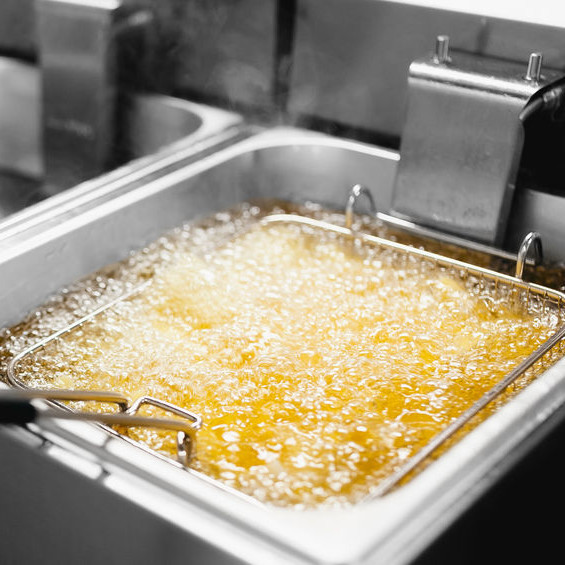
Frying Fats
Also known as frying oils or frying shortenings
What are Frying Fats?
Frying fats represent the cooking or heat transfer medium in which bakery products such as yeast-raised and cake doughnuts are processed.
Frying fats are partially responsible for the unique and characteristic flavor, aroma and texture of fried bakery goods. Different fats confer different flavor and other sensory characteristics and often affect their processing performance.
How does it work?
High-speed bakers with dedicated frying operations rely on heavy duty and flexible shortenings, oils and/or fats for production of a wide variety of snacks and bakery products.
Frying fats must be stable to oxidation, high temperatures and should remain fully functional during their usage. This is why frying fats, oils and shortenings are refined, bleached, deodorized and hydrogenated.
Stability of fats is related to the extent and type of unsaturation of the fatty acids components of fats or oils, and relative reaction rates of unsaturated fatty acids (UFAs) with oxygen.1
Types of frying fats
| Oil
(liquid or partially liquid at 86°F or 20°C) |
Shortening
(blend of fats and oils) |
Fat
(solid or partially solid at 86°F or 20°C) |
|
|
|
The properties and functionality of frying fats are largely influenced by the configuration of fatty acids contained in the triglyceride molecule:
- The longer the fatty acid chain, the higher the melting point, and the higher the fat stability to oxidation.
- The more saturated fatty acids, the more stable is the fat against oxidation.
Changes in fats during frying
Exposure of fats to high temperatures during frying causes them to degrade with an irreversible aging process. Types of degradation reactions include:2
- Oxidation
- Hydrolysis
- Polymerization
These reactions produce a variety of physical and chemical changes in the fat, oil or their blends, including increased viscosity (due to polymerization), evolution of volatile compounds (aromas), polarity (total polar materials), increased free fatty acid content (from hydrolysis), color development (darkening), and tendency of the oil to foam (due to gumming caused by polymerization).
Methods for detecting oil/fat oxidation include: iodine value, refractive index, oxidation stability index (OSI) and my others.2,3
Application
Physical and chemical specifications for frying fats include:
- Moisture: 0.15% max
- Free fatty acids (FFA): 0.10% max. This value helps determine stability. High levels indicate inadequate refining or breakdown.
- Melting point: 104–122°F (40–50°C)
- Polyunsaturation: 4.0–8.0%
- Solids fat index (SFI – Proportion of solid to liquid at given temperature):
- 36% at 50°F (10°C)
- 18% at 92°F (33°C)
- 26% at 70°F (21°C)
- 10% at 104°F (40°C)
- 23% at 80°F (27°C)
- Smoke point: 450°F (232°C)
- Peroxide value (milliequivalent/Kg): 1.0 max (measures oil/fat rancidity)
- Iodine value: 65–75 (amount of unsaturation or double bonds present in fatty acid chains)
- AOM (active oxygen method) stability: 100–200 hours
- Color: pale-white
- Flavor and odor: bland, free of foreign matter, flavors and odors
Handling and usage recommendations for frying fats
- Desired fat turnover is ⅓ of the fryer capacity/day.
- Filtering of fat should be performed at least once per day. Filtering is a function of the type of product being fried and amount of crumbs generated.
- Cleaning of fryers is a critical operation. Cleaning procedures should be carried out properly to minimize the amount of residual water and detergents on equipment’s product-contact surfaces.
- Chemical indices of fat/oil degradation should be monitored.
- Exposure to ultraviolet (UV) light should be minimized to extend the service life of fat/oil.
- Final rinsing should use vinegar (or acetic acid/water solutions).
- Frying fat must never come into direct contact with copper and brass. These materials used in processing equipment construction can act as catalysts in fat breakdown reactions.
- Avoid excess dusting flour left on doughnuts as it can gradually burn during product frying cycles, increasing the rate of fat breakdown.
- The use of old or used (broken down) frying fat should be avoided.
Old frying fats
Ways to detect or identify old frying fats (heat-abused) include:
- Color: dark coloration of fats is an indication of their overuse, aging, etc.
- FFA content: old frying fats usually have a FFA content higher than 1.0%.
- Viscosity: the older the fat, the thicker it gets. Food products fried with old fats usually look soggy, greasy, and less appetizing.
- Excessive foaming
- Low smoke point: the smoke point of an oil decreases with use because of an increase in low-molecular weight compounds such as FFA.
References
- Erickson, D.R. “Production and Composition of Frying Fats.” Deep Frying Chemistry, Nutrition, and Practical Applications, 2nd edition, AOCS Press, 2007, pp. 3–24.
- Warner, K. “Chemical and Physical Reactions in Oil During Frying.” Frying Technology and Practices, AOCS Press, 2004, pp. 22–34.
- Zeb, A. “Safety Assessment of Food Frying.” Food Frying: Chemistry, Biochemistry, and Safety, John Wiley & Sons Ltd, 2019, pp. 349–360.

